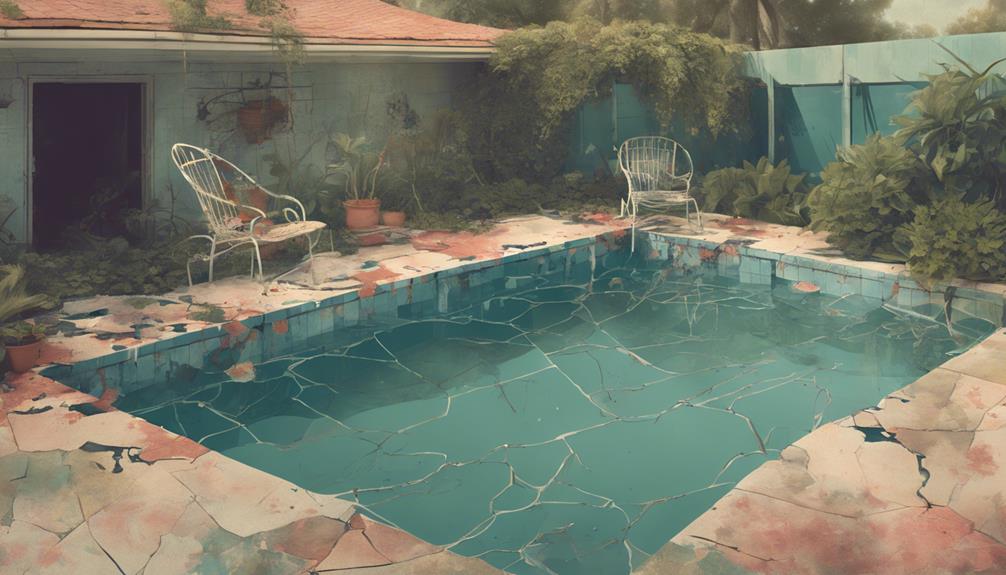If the surface of your pool looks rough, discolored, or has visible cracks, it may be time to consider resurfacing. This can help address wear and tear issues and restore the pool’s appearance and integrity. Additionally, pool resurfacing offers benefits such as enhancing aesthetics, preventing staining, and maintaining structural strength. To ensure your pool stays in top condition, remember to regularly clean surfaces, monitor chemical levels, and promptly fix any leaks. Following these maintenance tips can extend the life of your pool and ensure a safe swimming environment.
Key Takeaways
- Rough or discolored pool surface indicates the need for resurfacing.
- Cracks, stains, or cuts on the pool surface signal it's time for a makeover.
- Faded or worn-out appearance suggests the pool is due for resurfacing.
- Enhance safety and aesthetics by resurfacing to prevent further damage.
- Regular maintenance and inspections can help determine if your pool needs a makeover.
Signs Your Pool Needs Resurfacing
When considering the need for pool resurfacing, it is important to be vigilant for specific signs indicating that the pool surface requires attention. Signs such as a rough or worn pool surface, mineral stains from iron or copper, cuts or scrapes from the pool surface, fading or discoloration of the pool surface, and visible cracks or chips in the pool surface are key indicators.
These signs not only affect the visual appeal of the pool but can also lead to further damage and safety hazards if left unattended. Regularly inspecting your pool for these signs can help you address resurfacing needs promptly, ensuring the longevity and functionality of your pool.
Benefits of Pool Resurfacing
As pool resurfacing plays a crucial role in maintaining the structural integrity and visual attractiveness of a pool, understanding the benefits of this maintenance practice is essential for pool owners.
Pool resurfacing helps prevent staining and degradation, safeguards against temperature effects, and prevents plaster degradation and rusting. By enhancing the pool's aesthetics and providing a waterproof layer, resurfacing prolongs the lifespan of the pool surface.
Regular resurfacing also guarantees a smoother and safer pool surface, reducing the risk of cuts, scrapes, or other injuries. Overall, investing in pool resurfacing not only enhances the visual appeal of the pool but also contributes to its longevity and the safety of those enjoying it.
Tips for Pool Maintenance and Care

Effective pool maintenance and care are vital for preserving the longevity and functionality of your pool. To guarantee prime performance, regularly clean pool surfaces to prevent buildup. Monitor chemical balance for safe swimming conditions and promptly address any leaks to prevent water loss and damage.
Additionally, trimming surrounding vegetation can prevent debris from entering the pool and clogging filters. It is essential to schedule routine pool inspections and maintenance to identify and address any issues early on. Seeking professional services, like Shoreline Pools, for maintenance and care can provide expert guidance and ensure the proper upkeep of your pool.
Frequently Asked Questions
How Do I Know if My Pool Needs Resurfacing?
Determining the need for pool resurfacing involves examining signs like rough surfaces, stains, cuts, fading, cracks, and chips. Regular resurfacing prevents degradation, enhances aesthetics, and maintains a waterproof layer. Seek professional advice for accurate assessment and timely maintenance.
Can Resurfacing Fix Cracks in My Pool?
Smooth out the rough waters – resurfacing can mend cracks in your pool. Addressing structural issues early prevents further damage. Be sure to consult professionals like Shoreline Pools for expert guidance and reliable solutions.
Is Resurfacing Suitable for All Types of Pools?
Resurfacing is a versatile solution suitable for various pool types, including plaster, fiberglass, and concrete pools. It provides essential benefits like enhancing aesthetics, preventing staining, and ensuring structural integrity. Consult professionals for tailored advice.
What Is the Average Cost of Pool Resurfacing?
When considering pool resurfacing, costs range based on pool size, material, and desired finish. On average, pool resurfacing can cost between $5,000 to $10,000. Seek quotes from reputable professionals like Shoreline Pools for accurate estimates.
How Long Does Pool Resurfacing Typically Take?
Pool resurfacing typically takes 1-2 weeks, depending on pool size and surface material. It involves draining the pool, preparing the surface, applying new finish, and curing. Professional services like Shoreline Pools guarantee timely and quality completion.
Why Is Fall a Good Time for Pool Renovation?
Fall is the perfect time for pool renovation season kickoff. As the weather cools down, there’s less demand for the pool, making it an ideal time for upgrades. Plus, getting the renovation done now means your pool will be ready to go when the warm weather returns.
How Does the Level of Free Chlorine Impact the Need for a Pool Makeover?
The importance of free chlorine in pools cannot be overstated when it comes to the need for a pool makeover. A proper level of free chlorine is essential for keeping the water clean and safe for swimmers. Without it, the pool may quickly become dirty and algae-prone, requiring a costly and time-consuming makeover.
How Does Free Chlorine Help in Improving the Condition of Your Pool?
Free chlorine is crucial for vital pool maintenance chlorine and helps in improving the condition of your pool. It effectively kills bacteria and other harmful microorganisms, ensuring a safe and clean swimming environment. Maintaining the right balance of free chlorine levels is essential for preventing algae growth and maintaining clear, healthy water.
How Can Free Chlorine Help Improve the Appearance of My Pool?
Free chlorine is a vital pool maintenance chlorine that can help improve the appearance of your pool. It works to eliminate bacteria and algae, resulting in a clearer and cleaner pool. Regularly testing and adjusting the free chlorine levels can ensure that your pool remains a pleasant and inviting place to swim.
Conclusion
In the intricate tapestry of pool maintenance, recognizing the signs of wear and embracing the transformative power of resurfacing can breathe new life into your aquatic sanctuary.
By heeding these warning signs and investing in professional care, you can guarantee that your pool remains a pristine oasis for years to come.
Just as a phoenix rises from its ashes, let your pool emerge rejuvenated and resilient through the art of resurfacing.










